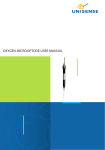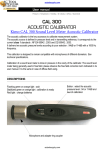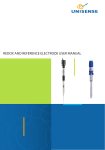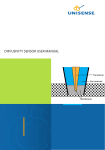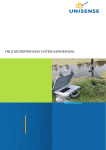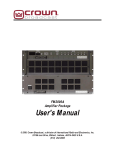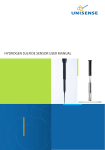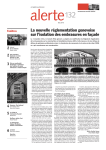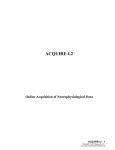Download N 2 O Sensor Manual
Transcript
NITROUS OXIDE SENSOR USER MANUAL Nitrous oxide sensor manual Copyright © 2015 · Unisense A/S Version July 2015 NITROUS OXIDE SENSOR MANUAL UNISENSE A/S TABLE OF CONTENTS WARRANTY AND LIABILITY . . . . . . . . . . . . . . . . . . . . . . . . . . . . . . . . . . . . . . . . . . . . . . . . . . . 6 CONGRATULATIONS WITH YOUR NEW PRODUCT! . . . . . . . . . . . . . . . . . . . . . . . . . . . . 7 Support, ordering, and contact information 7 OVERVIEW . . . . . . . . . . . . . . . . . . . . . . . . . . . . . . . . . . . . . . . . . . . . . . . . . . . . . . . . . . . . . . . . . . . . 9 GETTING STARTED . . . . . . . . . . . . . . . . . . . . . . . . . . . . . . . . . . . . . . . . . . . . . . . . . . . . . . . . . . 10 Unpacking and connecting a new sensor Pre-activation and Polarization Pre-activation procedure Polarization Calibration Zero nitrous oxide reading Nitrous oxide response reading 10 10 11 11 12 12 12 MEASUREMENTS . . . . . . . . . . . . . . . . . . . . . . . . . . . . . . . . . . . . . . . . . . . . . . . . . . . . . . . . . . . . 15 Mounting the sensors Electrical noise Interference 15 15 16 ADVANCED USE OF THE N2O SENSOR . . . . . . . . . . . . . . . . . . . . . . . . . . . . . . . . . . . . . . . . 17 STORAGE AND MAINTENANCE . . . . . . . . . . . . . . . . . . . . . . . . . . . . . . . . . . . . . . . . . . . . . . 18 Cleaning the sensor 18 REFERENCES . . . . . . . . . . . . . . . . . . . . . . . . . . . . . . . . . . . . . . . . . . . . . . . . . . . . . . . . . . . . . . . . . 19 TROUBLE SHOOTING . . . . . . . . . . . . . . . . . . . . . . . . . . . . . . . . . . . . . . . . . . . . . . . . . . . . . . . 20 APPENDIX: EQUILIBRIUM N2O CONCENTRATIONS . . . . . . . . . . . . . . . . . . . . . . . . . . 22 WARRANTY AND LIABILITY Notice to Purchaser This product is for research use only. Not for use in human diagnostic or therapeutic procedures. Warning Microsensors have very pointed tips and must be handled with care to avoid personal injury and only by trained personnel. Unisense A/S recommends users to attend instruction courses to ensure proper use of the products. Warranty and Liability The Nitrous Oxide sensor is covered by a 60 days limited warranty. Microsensors are a consumable. Unisense will only replace dysfunctional sensors if they have been tested according with the instructions in the manual within 14 days of receipt of the sensor(s). The warranty does not include repair or replacement necessitated by accident, neglect, misuse, unauthorized repair, or modification of the product. In no event will Unisense A/S be liable for any direct, indirect, consequential or incidental damages, including lost profits, or for any claim by any third party, arising out of the use, the results of use, or the inability to use this product. Unisense mechanical and electronic laboratory instruments must only be used under normal laboratory conditions in a dry and clean environment. Unisense assumes no liability for damages on laboratory instruments due to unintended field use or exposure to dust, humidity or corrosive environments. Repair or Adjustment Sensors and electrodes cannot be repaired. Equipment that is not covered by the warranty will, if possible, be repaired by Unisense A/S with appropriate charges paid by the customer. In case of return of equipment please contact us for return authorization. For further information please see the documents General Terms of Sale and Delivery of Unisense A/S as well as the manuals for the respective products. 6 CONGRATULATIONS WITH YOUR NEW PRODUCT! Support, ordering, and contact information The Unisense nitrous oxide microsensor is a miniaturized Clark-type nitrous oxide sensor with a guard cathode designed for research applications within environmental sciences. If you wish to order additional products or if you encounter any problems and need scientific/technical assistance, please do not hesitate to contact our sales and support team. We will respond to your inquiry within one working day. E-mail: [email protected] Unisense A/S Tueager 1 DK-8200 Aarhus N, Denmark Tel: +45 8944 9500 Fax: +45 8944 9549 Further documentation and support is available at our website www.unisense.com. REPLACEMENT OF SENSORS Unisense will replace sensors that have been damaged during shipment provided that: • The sensors were tested immediately upon receipt in accordance with the delivery note and the manual • The seal is still intact. • The sensors are returned to Unisense for inspection within two weeks. • The sensors are correctly packed for return to Unisense, in accordance with the note included in the sensor box. 7 RECOMMENDED AMPLIFIERS One-channel amplifier: Microsensor Monometer or Microsensor In Situ Amplifier Box Multi-channel amplifiers: Microsensor Multimeter 8 OVERVIEW This manual covers all the Unisense N2O sensors. With its minute tip size, excellent response time, and insignificant stirring sensitivity the Unisense nitrous oxide sensor makes it possible to make reliable and fast measurements with a high spatial resolution. WARNING Unisense sensors are neither intended nor approved for use on humans The Unisense nitrous oxide microsensor is a miniaturized Clark-type sensor with an internal reference and a guard cathode. In addition, the sensor is equipped with an oxygen front guard, which prevents oxygen from interfering with the nitrous oxide measurements. The sensor is connected to a high-sensitivity picoammeter and the cathode is polarized against the internal reference. Driven by the external partial pressure, nitrous oxide from the environment will penetrate through the sensor tip membrane and be reduced at the metal cathode surface. The picoammeter converts the resulting reduction current to a signal. The internal guard cathode is also polarized and scavenges oxygen in the electrolyte, thus minimizing zero-current and polarization time. AVAILABLE N2O SENSORS N2O25 (tip diameter 20-50 µm) N2O100 (tip diameter 70-120 µm) N2O-spec - customer specified 9 GETTING STARTED Unpacking and connecting a new sensor When receiving a new microsensor, first remove the shock-absorbing grey plastic net. Then secure the sensor in a safe position (e.g. micromanipulator or calibration chamber) before connecting it to the measuring meter. The signal from the nitrous oxide sensor is generated in picoamperes. Therefore the nitrous oxide sensor must be connected to a picoammeter amplifier unit during measurements. WARNING Do not remove the seal and protective plastic tube before these steps and calibration are successfully completed. Pre-activation and Polarization Please see procedure below. Pre-activation: Nitrous oxide sensors have a metal cathode which during normal exposure to oxygen over time will acquire an oxidated surface layer. If the sensor is new or has not been used recently, this layer must be “pre-activated” in order for the sensor to work. This is done by applying a voltage of -1.3 V for a short time prior to the period of polarization which is required for most electrochemical sensors. WARNING Incorrect polarization may destroy the sensor. Polarization: The electrolyte inside the sensor can contain large amounts of oxygen which must always be removed before the sensor is stable. This is done by the guard cathode inside the sensor during the period of polarization (for some other sensor types referred to as pre-polarization) and this process requires some time, depending on the dimensions and exact proportions of the individual sensor. IMPORTANT: If the sensor is new or not recently used, follow the procedure for PRE-ACTIVATION. For recently used N2O sensors, follow the procedure for POLARIZATION. Please read both sections before starting the relevant procedure. 10 For directions on adjusting the polarization on Microsensor Multimeter/Monometer or the PA2000, please consult the relevant manual. Pre-activation procedure 1. Secure the nitrous oxide sensor with its tip immersed in nitrous oxide free water. (It does not harm the sensor to be in air instead, but pre-activation, polarization, and calibration might as well be made with the same set-up). 2. Using a Microsensor Multimeter or Monometer: Connect the sensor to the amplifier. Turn the polarization to -1.3V and leave for approximately 30 minutes. Using a PA2000 amplifier: Connect ONLY the BNC connection of the sensor and turn the polarization voltage to -1.3 V. On the computer screen or display you will see a very high signal. Wait for five minutes. Polarization 1. Using a Microsensor Multimeter: Turn the polarization voltage to -0.8 V. Using a PA2000 amplifier: Turn the polarization voltage to -0.8 V. Connect the yellow guard wire to the yellow connection on the meter. 2. On the computer screen you will see a sharp decrease followed by a rapid increase in the signal. After this, the signal will stabilize with an initial rapid and then a 11 more slow decrease. Wait until the signal is below 20 mV and stable. This may take many hours, e.g. 12 hours (see below). If the sensor signal does not reach this value, please go to the Troubleshooting section. In general you should polarize for as long as possible before calibration and measurements to get maximum stability. Unisense recommends that you perform the pre-activation the day before measurements and then leave the sensor to be polarized overnight. If the signal does not stabilize or is too high or too low, see ‘Trouble-shooting’. Calibration Calibration must be performed after the sensor signal has stabilized. Nitrous oxide sensors respond linearly in the range of 0 to 2.5% nitrous oxide and signals can thus be linearly converted to partial pressure. Check and repeat calibration at appropriate intervals. Shortly after taking a sensor into use, the appropriate interval may be 2 hours; when the sensor has been used for some time, it may be 24 hours. To minimize the need for calibrations, keep the sensor polarized between measurements, unless the time between measurements exceeds several days. The membrane permeability of nitrous oxide microsensors changes with time, so a change in signal of up to 50% may occur over months. Zero nitrous oxide reading Place/keep the sensor tip in nitrous oxide free water and read the signal. This signal is your calibration value for zero nitrous oxide conditions. Nitrous oxide response reading The nitrous oxide sensor, in the standard version, responds linearly between 0-500 µM N2O (0-2.5% N2O. This does not apply for high range sensor versions. Therefore a two-point 12 IMPORTANT Calibration must be performed after pre-polarization when the sensor signal has stabilized. CALIBRATION As N2O microsensors respond linearly to changes in N2O concentrations, a two-point calibration is sufficient. calibration is sufficient. Prepare water with a defined nitrous oxide concentration (partial pressure), which is slightly above the maximum expected nitrous oxide concentration (partial pressure) in the samples. Never expose the sensor to concentrations more than the specified linear range - it may cause irreversible damage to the sensor. A defined nitrous oxide concentration can be obtained by two different procedures: b) Add a defined volume of nitrous oxide saturated water to a defined volume of water in a calibration chamber. For instance adding 3,679 ml of nitrous oxide saturated to 996,32 ml water gives a concentration of 100 µM at 20°C (see Table 1), as 3,679 ml of nitrous oxide saturated water contains WARNING Bubbling of water with any gas may cause the water to cool considerably. Monitor the temperature to find a suitable bubbling rate, which does not cool the water significantly. Calibration chamber CAL300 a) Use a gas mixture controller to obtain a defined mixture of nitrous oxide and nitrous oxide-free inert bulk carrier gas from a gas tank (e.g. N2) . For instance, to obtain a nitrous oxide concentration of 100 µM in the calibration chamber at 20°C, bubble the water in the calibration chamber with a gas mixture containing 1 atm. N2 and 0,003679 atm. N2O (nitrous oxide partial pressure 0.003679 atm. * solubility 27,05*10-3 mol/liter/atm. = 100 µmol/liter, see Table 1). For a Unisense 300 ml calibration chamber CAL300, 5 minutes of bubbling at a rate of 5 L per minute is sufficient time to achieve 99% of the concentration. If the equipment (gas mixture controller) is available, this method can be convenient, because it is possible to switch between different nitrous oxide conditions without changing the water. Use the solubility table (Table 1) to find the correct mixture at temperatures other than 20°C. For obtaining correct concentrations it is important that the headspace above the water in the calibration chamber is closed except for one hole, which should be only slightly larger than the microsensor shaft. This effectively prevents ambient air from entering the vessel. We recommend the Unisense Calibration chamber, CAL300, and rubber stoppers for calibrations. WARNING Never expose the sensor to concentrations more than 500 micromolar N2O - it may cause irreversible damage to the sensor* * Do not apply for high range sensor versions. 13 100 µmol nitrous oxide. Using a calibration chamber containing 200 ml, reduce the volume of added nitrous oxide saturated water by a factor of 5 for obtaining 100 µM, and so on. After adding nitrous oxide-saturated water to the calibration chamber, mix it thoroughly for a few seconds and read the signal when it is stable. Do not stir bubbles into the water and do not mix by bubbling, as this will flush nitrous oxide from the water. A magnetic stirrer is also not recommended as a mixing tool because it can introduce electrical noise to the signal. The nitrous oxide in the water will slowly escape to the atmosphere and the concentration can only be considered constant for a few minutes. If the sensor functions according to the above description, carefully remove the seal and the protective tube before making measurements. 14 MEASUREMENTS Nitrous oxide sensors can be used for a wide variety of measurements (please see our web page www.unisense.com for further information). They are most commonly used for making profiles in e.g. sediments or tissues where a high spatial resolution is required or for nitrous oxide measurements in water samples. Mounting the sensors Although the Unisense microsensors are made of glass, the tip is flexible and can adjust slightly around physical obstacles. The sensor is thus rather sturdy in the longitudinal direction. However, large obstacles like stones or lateral movements of the sensor when the tip is in contact with a solid substrate may cause the tip to break. TEMPERATURE Closely monitor the temperature. The temperature coefficient varies from sensor to sensor but is approximately 2-3% per oC. Furthermore, due to the small size of the microsensor tip and to the steepness of gradients in many environments, a displacement of the sensor tip of only a few microns may change its environment. Therefore, we recommend that measurements be performed only in a stabilized set-up free of moving or vibrating devices. We recommend the Unisense laboratory stand LS18 and the Unisense micromanipulator MM33 (double MM33-2) for laboratory use. For in situ use we recommend our in situ stand (IS19) and a micromanipulator. Electrical noise The signal of the microsensor is very small (10-13 to 10-10 ampere). Although both the Unisense picoammeter and the Unisense nitrous oxide microsensors are quite resistant to electrical noise from the environment, electrical fields may interfere with the sensor signal. Therefore we recommend that unnecessary electrical/mechanical equipment is switched off and the sensor or wires are not touched during measurements and signal recording. 15 Interference Exposure to high concentrations of sulfide should be avoided as it can affect the sensitivity of the nitrous oxide microsensor. Nitric Oxide (NO) is interfering the N2O sensor signal. On suspicion of sensor damage, repeat calibration and consult ‘Trouble-shooting’. 16 ADVANCED USE OF THE N2O SENSOR Unisense can construct nitrous oxide sensors for customer requested applications at an additional cost. Unisense provides several options for customizations (e.g. tip size, response time, pressure tolerance, and stirring sensitivity) and adaptations (e.g. mounting in needle or flow-through cell), making accurate measurements possible for even more applications. Please visit our website for more information. 17 STORAGE AND MAINTENANCE Always store the sensor in the protective plastic tube used for shipping. The nitrous oxide microsensor can be stored with the tip exposed to water or air. The room in which the microsensor is stored should be dry and not too hot (10-30°C). If the sensor is used regularly it can be stored polarized. Cleaning the sensor Depending on which substance is present on the sensor tip or membrane, the sensor can be cleaned with different solutes. The standard method is to rinse with 96% ethanol, then rinse with 0.01 M HCl and rinse with water. This will remove most substances. Alternatively it is possible to rinse with 0.1M NaOH, isopropanol, or other detergent 18 REFERENCES • Andersen, K., T. Kjaer, and N. P. Revsbech. 2001. An oxygen insensitive microsensor for nitrous oxide. Sensors and Actuators B-Chemical. 81(1):42-48. • Elberling, B., Christiansen, H.H. and Hansen, B.U. 2010. High nitrous oxide production from thawing permafrost. Nature geoscience 3:332-335. Abstract • Horn, M., A. Schramm, and H.L. Drake. 2003. The earthworm gut: an ideal habitat for ingested N2O-producing microorganisms. Appl. Environ. Microbiol. 69, 1662-1669. • Revsbech, N. P., and B. B. Jørgensen. 1986. Microelectrodes: Their Use in Microbial Ecology, p. 293-352. In K. C. Marshall (ed.), Advances in Microbial Ecology, vol. 9. Plenum, New York. 19 TROUBLE SHOOTING Problem Possible cause Insoluble compounds deposited at the sensor tip Solution Rinse with 96% ethanol, rinse with 0.01M HCl and rinse with water Problem An unstable signal or the signal fluctates if the setup is touched or equipmen is introduced in the medium you are measuring in Electrical disturbance of the sensor through the tip membrane Possible cause Solution Ground the set-up using the blue grounding cable supplied with the picoammeter. Connect the reference plug on the picoammeter (blue plug) with the medium you are measuring in. Problem High and drifting signal Possible cause The sensor tip is broken Solution Replace the microsensor Problem A high signal Possible cause Solution Possible oxygen interference if the oxygen front guard is damaged Replace the microsensor Problem A high signal (2) Possible cause Solution 20 A slow response Air is trapped in the tip Degas water by boiling and subsequent cooling or by 10 min of vacuum treatment. Immerse the sensor tip for 20 min in the degassed water. Repeated or prolonged treatment may be necessary. Problem Possible cause Solution The signal is very low Contamination of the cathode surface (e.g. by sulfide) or loss of the cathode material due to excessive vibration. Replace the microsensor. If you encounter other problems and need scientific/technical assistance, please contact [email protected] for online support (we will answer you within one workday) 21 APPENDIX: EQUILIBRIUM N2O CONCENTRATIONS Equilibrium nitrous oxide concentrations (mmol/liter) at ambient partial pressure of 1 atm. in water as a function of temperature and salinity. (‰) / oC 0 5 10 16 22 26 30 36 40 0 59.35 48.46 40.16 32.66 27.05 24.09 21.61 18.61 16.98 10 55.85 45.73 37.99 30.96 25.69 22.91 20.57 17.73 16.18 20 52.58 43.15 35.93 29.35 24.40 21.78 19.58 16.89 15.42 30 49.50 40.73 33.98 27.82 23.18 20.71 18.63 16.09 14.70 35 48.03 39.56 33.05 27.09 22.59 20.19 18.18 15.70 14.35 38 47.17 38.88 32.50 26.66 22.24 19.89 17.91 15.48 14.15 40 46.60 38.43 32.14 26.37 22.01 19.69 17.73 15.33 14.01 Source: Weiss, R.F; Price, B. A.: Marine, Chemistry, 1980, 8, 347-359 22 UNISENSE, DENMARK www.unisense.com · [email protected]



























